Benefits, Use Cases, and More

In the dynamic landscape of the telecommunications industry, several challenges persist, demanding innovative solutions to ensure sustainable growth and competitiveness. One of the foremost challenges is the exponential increase in data consumption driven by the proliferation of connected devices and bandwidth-intensive applications. This surge in data traffic strains network infrastructure, leading to congestion and degraded service quality, especially during peak usage hours.
However, artificial intelligence (AI) has emerged as a potential game-changer to this conundrum, promising to simplify these complex issues. Telecommunication businesses are gradually tapping into this potential, deploying AI solutions to optimize service operations at various touchpoints, from refining in-store customer experiences to enhancing call center efficiency.
Despite the formidable economic challenges, integrating AI in telecom sector holds significant potential value, with industry leaders already reaping the rewards. As networks evolve towards software-defined and cloud-based infrastructures, maintaining competitiveness necessitates technological advancement and alignment with AI-driven innovations embraced by industry frontrunners.
As per the report of Precedence Research, the estimated value of the global AI in telecommunications market stood at approximately $1.34 billion in 2023, with projections indicating a surge to about $42.66 billion by 2033. This growth trajectory reflects a robust CAGR of 41.40% from 2024 to 2033.
The telecom industry has witnessed a paradigm shift with the rapid advancement of artificial intelligence, delivering outstanding outcomes. Therefore, it is imperative for telecom businesses to capitalize on this technology to achieve their strategic objectives efficiently.
Let’s delve into the transformative potential of AI for telecom and uncover the innovative strategies for its integration.
Leveraging AI in Telecommunications for Optimal Strategic Advantage
Artificial intelligence has become ubiquitous in the telecommunications industry, revolutionizing operations, enhancing network efficiency, and minimizing errors. Furthermore, harnessing AI in telecommunications enables predictive maintenance, enhances customer service through personalized experiences, and optimizes network performance.
According to an IDC report, global spending on Telecom Services reached $1,509 billion in 2023, reflecting a 2.1% increase over the preceding year. IDC projects a further 1.4% increase in worldwide investment in Telecom services by the end of 2024, with a total projected expenditure of $1,530 billion.
The report suggests that the integration of artificial intelligence (AI) and advanced analytics within the telecommunications industry has ushered in a new era of operational enhancement and efficiency. AI can anticipate network congestion, hardware failures, and other performance bottlenecks through predictive maintenance algorithms, allowing operators to allocate resources and maintain uninterrupted service delivery preemptively.
Let’s explore further how AI is reshaping the telecom landscape beyond these aspects.
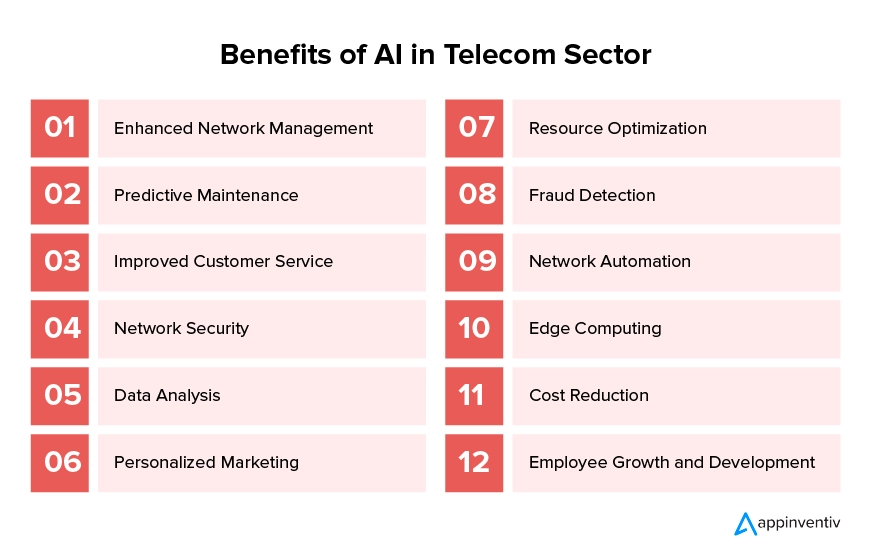
Enhanced Network Management
AI algorithms analyze vast amounts of network data in real-time, enabling telecom companies to optimize network performance, predict potential issues, and proactively address them. By continuously monitoring network traffic, AI can identify patterns and anomalies, allowing for more efficient resource allocation and traffic routing.
Predictive Maintenance
Leveraging AI, telecom operators can implement predictive maintenance strategies by analyzing historical data to forecast equipment failures and performance degradation. By detecting early signs of potential issues, such as equipment malfunctions or signal degradation, companies can schedule maintenance activities proactively, minimizing downtime and optimizing resource utilization.
Improved Customer Service
AI-powered chatbots and virtual assistants have revolutionized customer service in the telecom industry. These intelligent systems can handle a wide range of customer inquiries, from account management to technical support, providing instant responses and personalized recommendations. By automating routine tasks and offering 24/7 support, AI-driven customer service solutions enhance customer satisfaction and loyalty.
Through advanced analytics and natural language processing, AI enhances self-service capabilities, empowering customers to effortlessly navigate services and troubleshoot issues, thereby elevating overall satisfaction levels. Moreover, AI contributes to self-healing customer experiences by strengthening operational efficiency.
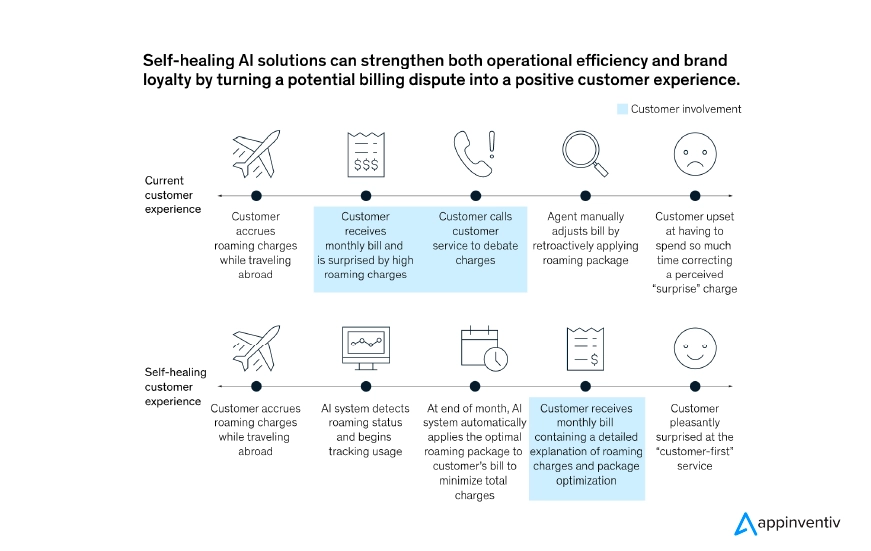
Network Security
With the increasing complexity and frequency of cybersecurity threats, AI plays a crucial role in safeguarding telecom networks against malicious activities. AI-powered security systems can analyze network traffic in real-time, detect suspicious behavior, and respond to threats proactively. By continuously learning from new data and evolving threat landscapes, AI enhances network security and mitigates the risks of data breaches and cyberattacks.
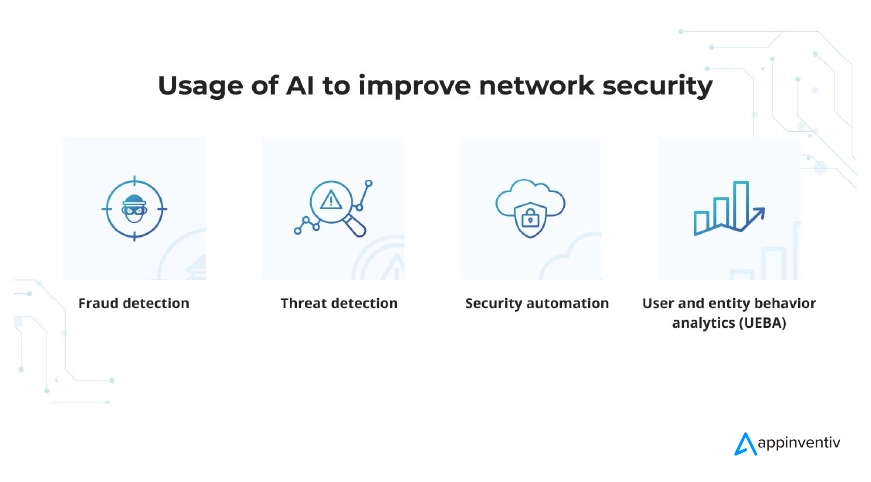
Data Analysis
Telecom companies generate vast amounts of data from network operations, customer interactions, and market trends. AI-powered analytics tools enable companies to extract valuable insights from this data, uncovering hidden patterns, trends, and correlations. By leveraging advanced data analysis techniques, telecom operators can make data-driven decisions, optimize service offerings, and identify new revenue opportunities.
Personalized Marketing
AI algorithms analyze customer behavior, preferences, and demographic data to deliver personalized marketing campaigns and promotions. By segmenting customers based on their interests and purchasing history, telecom companies can target their marketing efforts more effectively, increasing engagement and conversion rates. Personalized AI-powered marketing initiatives enhance customer loyalty and satisfaction while driving revenue growth.
Resource Optimization
AI-driven optimization techniques enable telecom companies to maximize the efficiency of their resources, including spectrum, bandwidth, and network infrastructure. AI optimizes network performance while minimizing operational costs by dynamically allocating resources based on demand, traffic patterns, and service requirements. AI-powered resource optimization strategies help telecom operators meet the growing demands for high-speed connectivity and bandwidth-intensive applications.
Fraud Detection
Telecom fraud significantly threatens revenue streams and customer trust. AI-powered fraud detection systems can analyze vast amounts of transactional data, identify fraudulent patterns and anomalies, and flag suspicious activities in real-time. By leveraging machine learning algorithms, telecom operators can detect various types of fraud, including identity theft, subscription fraud, and unauthorized access, preventing financial losses and protecting data.
Network Automation
AI-driven automation technologies streamline network operations and management tasks, reducing manual intervention and human errors. By automating routine processes such as network provisioning, configuration management, and performance monitoring, AI enables telecom operators to scale their operations efficiently and improve overall service quality. Network automation powered by AI enhances agility, flexibility, and scalability, enabling telecom companies to meet evolving customer demands and market dynamics.
Edge Computing
With the proliferation of IoT devices and applications, telecom operators are increasingly adopting edge computing architectures to process data closer to the source. AI-powered edge computing solutions enable telecom companies to analyze and act on data in real-time, reducing latency and improving the responsiveness of IoT applications. By deploying AI algorithms at the network edge, telecom operators can deliver low-latency services, optimize bandwidth usage, and enhance the performance of mission-critical applications.
Cost Reduction
By automating repetitive tasks, optimizing resource allocation, and minimizing downtime, AI helps telecom companies lower operational costs and improve profitability. AI-driven efficiency improvements enable telecom operators to achieve greater economies of scale, reduce infrastructure investments, and streamline service delivery processes. By optimizing operational efficiency and resource utilization, AI contributes to cost reduction initiatives across all aspects of telecom operations, from network management to customer service.
Employee Growth and Development
AI in the telecommunication industry plays a crucial role in fostering employee growth and development. AI-powered analytics tools provide personalized insights and recommendations to employees, helping them identify areas for improvement and skill enhancement. Moreover, AI-driven training programs deliver targeted learning experiences tailored to individual employee needs, promoting continuous learning and skill development within the organization.
Telecommunication companies are at the early stages of harnessing AI’s potential, as operators begin to see positive outcomes from AI solutions in optimizing service operations. These solutions, which improve in-store customer interactions and call center efficiency, also play a crucial role in deploying employees across different settings such as stores, call centers, and field operations, as noted by McKinsey & Company.
As a result, employees feel more empowered, motivated, and equipped to contribute effectively to the company’s success, ultimately leading to a more skilled and resilient workforce.
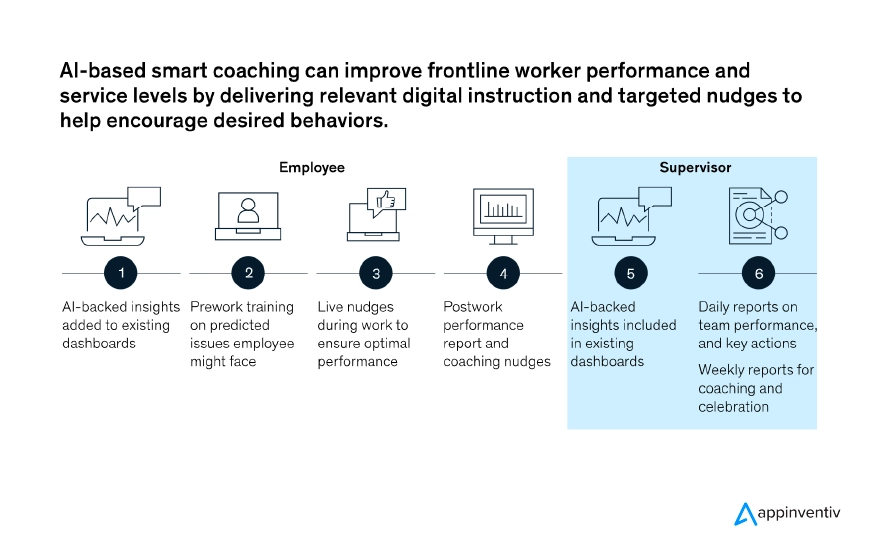
AI in Telecom Use Cases
Artificial intelligence is reshaping the telecommunications industry by providing a variety of innovative solutions. Let’s delve into the transformative applications of AI in telecommunication that businesses utilize to enhance connectivity and communication.
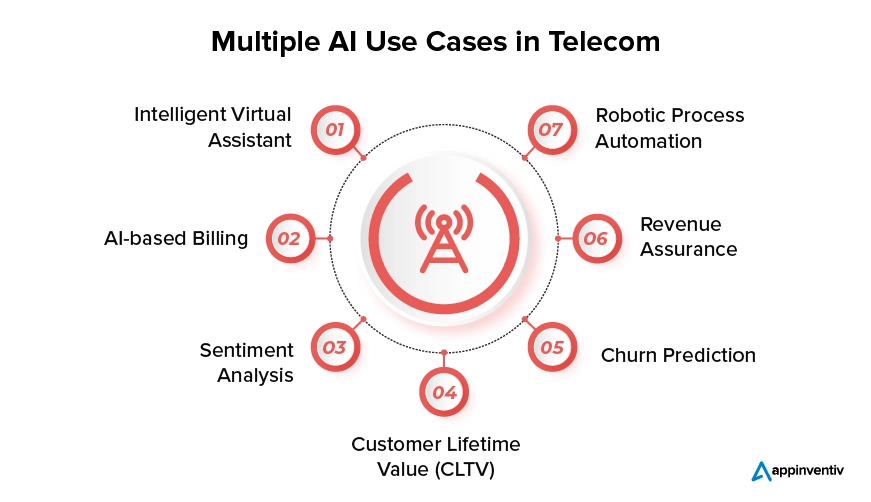
Intelligent Virtual Assistant
AI-driven virtual assistants in telecom handle customer inquiries, personalize support, and streamline interactions, reducing operational costs and enhancing customer satisfaction. Their 24/7 availability ensures constant support, improving accessibility and responsiveness for telecom customers.
AI-based Billing
Utilizing AI, telecom billing systems analyze usage patterns, detect errors, and generate accurate invoices in real-time, enhancing billing accuracy and transparency. By automating billing processes, they optimize resource utilization and minimize manual errors, increasing operational efficiency.
Sentiment Analysis
Leveraging natural language processing and machine learning, sentiment analysis in telecom interprets customer feedback to uncover insights and trends. It enables telecom companies to identify emerging issues and opportunities, facilitating proactive responses and reputation management.
Customer Lifetime Value (CLTV)
Using predictive analytics, telecom operators estimate the long-term value of customers, informing acquisition and retention strategies. By identifying high-value customers, AI-driven CLTV analysis enables telecom companies to tailor services and incentives, maximizing customer lifetime value.
Churn Prediction
Churn prediction is a vital application of AI in telecommunication industry. It identifies customers who are likely to switch to a competitor or terminate their subscription. By analyzing various factors such as usage patterns, billing history, and customer interactions, AI algorithms can predict churn probabilities for individual subscribers. Telecom companies can then proactively intervene by offering personalized incentives, tailored retention strategies, or targeted marketing campaigns to mitigate churn and retain valuable customers.
Revenue Assurance
Revenue assurance, another critical AI application in telecom, plays a significant role in ensuring the accuracy and completeness of revenue streams while minimizing revenue leakage and fraud. AI algorithms, with their ability to analyze vast volumes of transactional data, identify discrepancies, anomalies, or irregularities in billing and revenue collection processes. By automating revenue reconciliation, detecting fraudulent activities, and optimizing revenue assurance workflows, telecom operators can confidently safeguard their revenue streams, enhance financial performance, and maintain regulatory compliance.
Robotic Process Automation
Robotic Process Automation (RPA) is revolutionizing operational efficiency in the telecom industry by automating repetitive tasks, processes, and workflows through AI-driven software robots or bots. By deploying RPA in telecom operations, companies can improve productivity, accelerate time-to-market, and enhance customer experiences through faster and more accurate service delivery.
Real-World Examples of Businesses Leveraging AI in Telecom
In the rapidly evolving telecommunications industry, the integration of AI is driving innovation and reshaping operational paradigms. Here are some real world examples of AI in telecom industry, leading the charge in leveraging AI to transform their operations and enhance customer experiences:
Vodafone
Vodafone, one of the world’s largest telecommunications companies, utilizes AI to enhance network performance, optimize resource allocation, and personalize customer experiences. They employ AI-driven predictive analytics for proactive network maintenance, AI-powered chatbots for customer support, and machine learning algorithms for targeted marketing campaigns.
AT&T
AT&T, a leading telecommunications provider in the United States, integrates AI across its network infrastructure and customer-facing services. They leverage AI for network optimization, predictive maintenance, and fraud detection. AT&T also offers AI-powered virtual assistants and personalized recommendation engines to enhance customer interactions and satisfaction.
China Mobile
China Mobile, the largest telecommunications company in the world by subscribers, harnesses AI to improve network efficiency, manage traffic congestion, and analyze customer data. They deploy AI algorithms for network planning and optimization, customer segmentation, and predictive maintenance. China Mobile also offers AI-based services such as virtual assistants and personalized content recommendations to enrich the customer experience.
Generative AI in Telecom: Powering the Present and the Future
Generative AI is revolutionizing the telecom industry, offering transformative capabilities that power both current operations and future innovations. With generative AI, telecom companies can unlock new possibilities, paving the way for network optimization, customer engagement, and service personalization.
By leveraging generative models, telecom operators can simulate various network configurations and scenarios, enabling them to identify optimal setups that maximize efficiency and performance. This approach allows for more agile and adaptive network management, ensuring seamless connectivity and improved user service quality.
By harnessing gen AI, telcos can also unlock new levels of innovation and differentiation, positioning themselves to capture a significant share of the industry’s incremental value and productivity gains.
However, realizing the full potential of gen AI requires telcos to overcome challenges such as talent acquisition, data governance, and organizational change management, necessitating a holistic approach and CEO-led commitment to innovation and transformation.
Within the telecom sector, outdated operating procedures persist, hindering profitability. However, integrating Gen AI offers promising avenues for increased profitability. Notably for the telecom operators, as per Forbes, returns on incremental margins by employing Gen AI solutions can grow from 3% to 4% within two years and up to 8% to 10% within five years. This can be achieved through enhanced customer revenue via improved customer life cycle management and reduced operating expenses.
Implementation of AI in Telecommunication Market
Implementing AI for telecom involves several key steps to ensure successful integration and deployment. Here’s a structured approach:
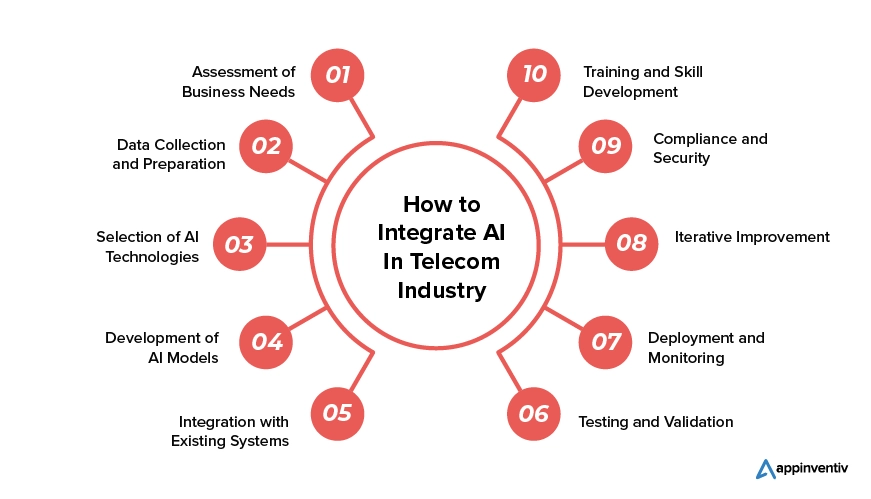
Assessment of Business Needs
Begin by identifying specific areas within the telecom operations where AI can bring the most value. This could include network optimization, customer service, billing, marketing, or security.
Data Collection and Preparation
Gather relevant data from various sources such as network logs, customer interactions, billing records, and market trends. Ensure the data is clean, organized, and properly labeled for training AI models.
Selection of AI Technologies
Choose the appropriate AI technologies based on the identified use cases and available data. This may include machine learning algorithms, natural language processing (NLP), computer vision, or predictive analytics.
Development of AI Models
Develop AI models tailored to the specific needs of the telecom operations. This involves training the models using historical data and validating their performance through testing and evaluation.
Integration with Existing Systems
Integrate the AI models with existing telecom systems and infrastructure. This may require collaboration with IT teams to ensure compatibility and seamless operation.
Testing and Validation
Conduct thorough testing of the AI implementation to verify its functionality, accuracy, and performance. This includes testing under various conditions and scenarios to identify and address any potential issues.
Deployment and Monitoring
Once validated, the AI solutions will be deployed into production environments. Continuously monitor the performance of the AI models and gather feedback from users to identify opportunities for improvement.
Iterative Improvement
Implement a process for iterative improvement based on feedback and performance metrics. This may involve retraining AI models with updated data, fine-tuning parameters, or implementing new features to address evolving needs.
Compliance and Security
Ensure compliance with regulatory requirements and industry standards for data privacy, security, and ethical use of AI technologies. Implement appropriate measures such as GDPR to safeguard sensitive information and mitigate potential risks.
Training and Skill Development
Provide training and support to employees to familiarize them with the AI technologies and tools being implemented. Encourage ongoing learning and skill development to leverage the full potential of AI for telecom operations.
Telecom Industry Challenges: Implementing AI Efforts
Implementing AI in the telecom sector poses various challenges. Let’s delve into these obstacles and their holistic solutions to ensure a comprehensive approach to AI integration.
Challenge: Explainability and Transparency
AI models can sometimes be “black boxes,” making it difficult to understand their decision-making processes. This lack of transparency can raise concerns about fairness and bias, especially when dealing with sensitive customer data.
Solution: Implement model interpretability techniques such as feature importance analysis, model-agnostic explanations, and local interpretable model-agnostic explanations (LIME) to understand the factors influencing AI model predictions. Use transparent and interpretable model architectures, such as decision trees or linear models, whenever possible. Document and communicate the rationale behind model decisions, highlighting the key features and factors considered by the AI system.
Challenge: Talent Scarcity
The telecom industry faces a shortage of skilled professionals with AI development, deployment, and maintenance expertise. This talent gap can slow down the pace of adoption and innovation.
Solution: Invest in talent development initiatives, including training programs, workshops, and certification courses, to upskill existing employees and attract new talent with AI expertise. Partner with industry organizations to create specialized AI education and training programs tailored to the telecom sector. Foster a culture of continuous learning and knowledge sharing within the organization, encouraging employees to collaborate and exchange expertise in AI technologies.
Challenge: Complexity of Networks
Telecommunications networks are highly complex, with diverse technologies, protocols, and equipment. Integrating AI into such environments requires addressing interoperability issues, compatibility with legacy systems, and ensuring seamless interaction with network infrastructure.
Solution: Develop AI solutions that are modular, scalable, and interoperable, allowing seamless integration with diverse telecom network technologies and equipment. Leverage software-defined networking (SDN) and network function virtualization (NFV) technologies to abstract network complexity and enable centralized management and orchestration of AI-driven network optimization tasks. Implement standardized interfaces and protocols to facilitate interoperability and compatibility with legacy systems.
Challenge: Interpretability and Transparency
AI models used in telecom must be interpretable and transparent, especially for critical decision-making processes. Ensuring the explainability of AI algorithms and maintaining transparency in their operation is essential for gaining trust and acceptance from stakeholders.
Solution: Employ explainable AI techniques, such as rule-based models, surrogate models, and model-specific interpretability methods, to enhance the transparency and interpretability of AI models. Provide stakeholders with access to model documentation, including model architecture, training data, and evaluation metrics, to foster trust and transparency in AI decision-making processes. Establish clear guidelines and governance mechanisms for ethical AI implementation, ensuring that fairness, accountability, and transparency principles are upheld throughout the AI lifecycle.
Challenge: Ethical Considerations
Application of artificial intelligence in telecom raises ethical concerns related to bias, fairness, and accountability. Ensuring fairness in algorithmic decision-making, addressing biases in data, and establishing ethical guidelines for AI usage are essential for responsible AI implementation.
Solution: Conduct comprehensive ethical assessments and risk analyses to identify potential biases, fairness issues, and ethical concerns associated with AI applications in telecom. Implement fairness-aware machine learning techniques, such as bias detection and mitigation algorithms, to address biases in training data and model predictions. Establish ethical review boards or committees tasked with evaluating the ethical implications of AI projects and ensuring compliance with ethical guidelines and regulations. Foster a culture of ethical awareness and responsibility within the organization, encouraging employees to prioritize ethical considerations in AI development, deployment, and usage.
AI in the Telecom Industry: Envisioning Future Innovations
The future of AI in the telecom industry promises groundbreaking developments poised to redefine operational standards and customer interactions. Foreseen advancements include:
- The rise of autonomous network management, where AI-driven systems dynamically optimize resource allocation and performance to ensure uninterrupted service delivery.
- Additionally, businesses can expect the proliferation of AI-powered virtual assistants tailored for personalized customer support, offering real-time assistance and service recommendations.
- Furthermore, predictive analytics fueled by AI will enable proactive problem-solving by identifying and addressing potential issues before they escalate, enhancing network reliability and customer experiences.
Harnessing AI Excellence for Your Telecom Project: Capitalize on Our Expertise
As an AI development company, we recognize the vital role of AI in the telecommunications sector. Our expertise enables telecom businesses to leverage AI effectively, revolutionizing customer interactions and operational efficiency to achieve their strategic objectives.
Implementing AI for the telecom sector demands a comprehensive approach encompassing various aspects such as technological integration, thorough research, strategic planning, assembling a skilled team, and evaluating processes. Our comprehensive telecom software development services cover a wide spectrum, including machine learning and predictive analytics.
By focusing on delivering personalized experiences, automating intricate tasks, and uncovering profound insights into user behavior, we enable telecom businesses to develop AI-based platforms that not only enhance customer satisfaction and operational efficiency but also have the potential to transform the industry. Our approach is grounded in overarching strategies, ensuring that artificial intelligence in telecom not only meets but exceeds expectations through its transformative power.
Get in touch with us to explore how AI can revolutionize your telecommunications offerings, creating innovative solutions that boost engagement and elevate user experiences.
FAQs
Q. What are the latest advancements at the intersection of AI and telecommunications?
A. Artificial intelligence in telecom has become synonymous with groundbreaking advancements that are reshaping the industry’s landscape. Among these innovations are AI-driven network optimization, predictive maintenance algorithms, and personalized customer service solutions. These technological marvels represent a convergence of artificial intelligence and telecommunications, unlocking unprecedented possibilities for network efficiency, reliability, and customer satisfaction.
Q. How much does the development of AI solutions in the telecommunications industry typically cost?
A. The cost of developing AI solutions in telecom varies depending on factors such as the complexity of the project, the scope of functionalities, the expertise of the development team, and the integration with existing systems. Generally the costs differ from $30,000 to $4,00,000.
Q. How long does it typically take to develop an AI-based app for the telecommunications sector?
A. The timeframe for developing an AI-based app in the telecommunications sector is subject to variables such as project scope, complexity, and resource availability. Typically, the process spans several months to a year or longer, encompassing phases like planning, design, implementation, testing, and deployment.
Q. What are some applications of AI in telecom?
A. AI in telecom is revolutionizing various aspects of the industry with applications such as:
Network Optimization: AI algorithms continuously analyze network performance data to optimize network resources, enhance efficiency, and ensure seamless connectivity for users.
Predictive Maintenance: AI-powered predictive analytics anticipate potential network failures or equipment malfunctions, allowing telecom companies to perform proactive maintenance and minimize downtime.
Customer Service Chatbots: AI-driven chatbots provide instant customer support, assisting users with inquiries, troubleshooting network issues, and processing service requests efficiently.
Personalized Marketing: AI algorithms analyze customer data to create personalized marketing campaigns, tailored promotions, and targeted advertisements based on individual preferences and behaviors.
Fraud Detection: AI systems detect suspicious activities and patterns in real-time, enabling telecom companies to prevent fraud, unauthorized usage, and security breaches effectively.

THE AUTHOR
Sudeep Srivastava
Co-Founder and Director





